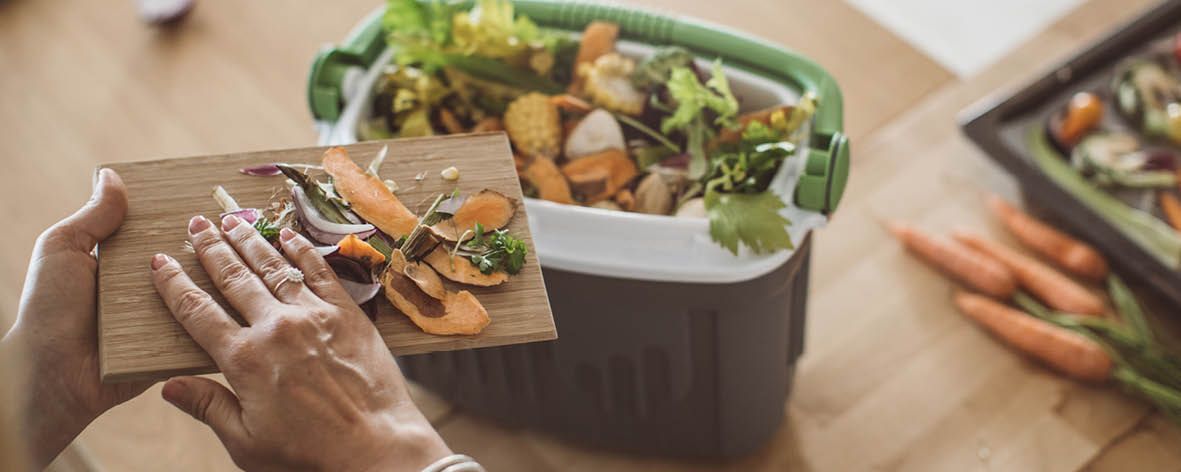Food waste … our top tips to help you cut down on waste at home

No-one likes to see food go in the bin, but the truth is that in Australia over 5 million tonnes of food ends up in landfill each year; that’s enough to fill 9,000 Olympic sized swimming pools! The 2019 National Food Waste Baseline Report shows that the average Australian household throws out 4.9 kilograms of food each and every week. So what can you do to reduce food waste? Read on for more information and our top tips.
Globally, one third of all food that is produced is lost or wasted. This statistic is even more horrifying when you realise that 793 million people don’t have enough food to eat. If just one-quarter of the food that is currently lost or wasted could be saved, it would be enough to feed 870 million hungry people. Eliminating food waste would also save 4.4 million tonnes of CO2 a year, the equivalent of taking one in four cars off the road.
Closer to home, the cost of food waste in Australia is estimated to be around $20 billion each year. Let’s bring it even closer to home with this alarming statistic – one in five shopping bags end up being wasted meaning that $3800 worth of groceries per household end up being thrown away every year! Add to that the wasted water, resources and energy that went into growing, harvesting and transporting the food and it equates to a giant problem.
So what can you do? We have some easy and money-saving changes that you can make at home that will make a difference.
1. Record
Keeping a list of what you throw away can be a real eye-opener. Take it one step further by adding a dollar value to what is going in the bin and you’re sure to get the incentive you need to waste less.
2. Plan
The first step to reducing food waste is to plan ahead. Shop smart by first looking through your pantry, fridge and freezer and making a note of what you have and what needs to be used soon. Then plan your meals around what you already have, writing a list of ingredients that you need for each meal and ticking off the items you have at home. Think about ingredients that can be used in multiple recipes so that you don’t end up throwing away half a packet of something at the end of the week. Use your ingredients list to make a shopping list. If you’re short on time, take a photo on your phone of the inside of your fridge and pantry before you head out shopping. This visual reminder is a powerful memory aid and will stop you buying things “just in case” you don’t have them.
3. Buy loose fruit and vegetables.
This not only reduces plastic waste but ensures that you are only buying what you need, meaning there is less likelihood of ending up with waste.
4. Portion control
Do you always have leftover rice or pasta? Avoid cooking more than you need by measuring first. As a rough guide a mug of uncooked rice will serve four people, while a mug of uncooked pasta will serve 2. When cooking don’t cook more than you know you will eat and don’t over-serve friends and family with big portions that won’t get eaten. If you do have leftovers save, and actually eat them. Label leftovers so that you know how long they have been in the fridge or freezer.
5. Know the difference
Not sure what is difference between ‘use by’ and ‘best before’? Use by dates indicate that there may be a safety risk if food is eaten after this date. Best before dates are indicators of quality, designed to show when food is at its best, although it is still ok to eat for a while after this date.
6. Rescue it
Wilted veg? Try reviving them by trimming the ends and dunking in a bowl of ice water. This also works well for herbs.
7. Use your freezer
Most of the foods you buy can be frozen before their use by date to extend their life. When freezing remember to seal bags or containers tightly to avoid freezer burn. Do a big batch-cook of foods like lasagne, curries, muffins and cakes and freeze whatever you aren’t using immediately for later meals. Overripe bananas can be frozen to make smoothies or banana bread; hard cheese can be grated and frozen to use in recipes, and ice-cube trays are ideal for freezing leftover herbs in oil, tomato puree, wine and pesto for using later in recipes.
8. Storage
Storing food correctly is vital to reducing food waste. Don’t automatically put all your fruit and veg into the fridge because some will keep better out of refrigeration.
9. FIFO
It can be easy to forget that something is in the fridge until it has started turning into a mouldy science experiment. If this happens to you try keeping things neat and visible and use the first in, first out principle. When you buy new food, move the older food to the front of the fridge or pantry so that it gets eaten first.
10. Go old school
Preserving and pickling are both great ways to increase the shelf life of food. Got a glut of summer stonefruit? Preserve it now and you’ll be enjoying peaches all through the winter.

